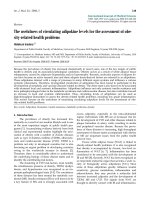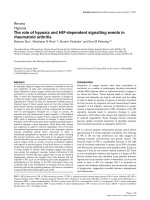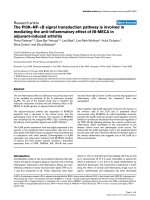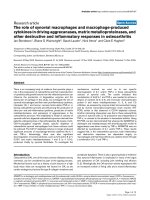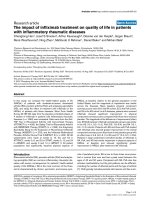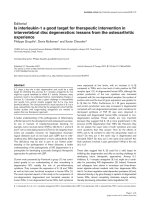Báo cáo y học: " The Opossum genome reveals further evidence for regulatory evolution in mammalian diversification" doc
Bạn đang xem bản rút gọn của tài liệu. Xem và tải ngay bản đầy đủ của tài liệu tại đây (141.89 KB, 4 trang )
Genome Biology 2007, 8:223
Minireview
The Opossum genome reveals further evidence for regulatory
evolution in mammalian diversification
Bernardo Lemos
Address: Department of Organismic and Evolutionary Biology, Harvard University, Divinity Avenue, Cambridge, MA 02138, USA.
Email:
Abstract
The sequencing of the euchromatic genome of a marsupial, the opossum Monodelphis domestica,
identifies shared and unique features of marsupial and placental genomes and reveals a prominent
role for the evolution of non-protein-coding elements.
Published: 9 August 2007
Genome Biology 2007, 8:223 (doi:10.1186/gb-2007-8-8-223)
The electronic version of this article is the complete one and can be
found online at />© 2007 BioMed Central Ltd
Mammalian diversification began approximately 250 million
years ago, yielding a stunning diversity of form and function
that falls into three major groups with fundamentally distinct
modes of reproduction. The monotremes (Prototheria)
comprise a handful of extant species of egg-laying mammals:
the platypus and a few species of echidna. Placentals (the
Eutheria) comprise about 4,500-5,000 species characterized
by lengthy gestation with placental nourishment and
neonates born at an advanced developmental stage and
often nearly independent from the mother. Marsupials (the
Metatheria) comprise about 250-300 species that are
characterized by a rudimentary placenta and short gestation,
after which poorly developed embryos are born and undergo
subsequent development during lactation, usually inside the
mother’s marsupium, or pouch.
Marsupial and placental mammals diverged about 125-190
million years ago [1-3]. While the marsupial radiation stopped
short of producing as many species as the placental one, the
impressive diversification of metatherians in South America
and Australia resulted in a wide array of life histories and
morphologies, many of which matched those observed in
placental mammals - from herbivores to insectivores to
carnivores. Two of the most notable cases are now extinct. The
Tasmanian wolf (Thylacinus), also known as the pouched dog
for its striking resemblance to placental canids, was heavily
hunted and the last individual died in captivity in an
Australian zoo in September 1936 [4]. Similarly, the marsupial
Thylacosmilus from the South American Miocene possessed
skull and saber-tooth morphologies with a remarkable
resemblance to those of placental saber-tooth tigers [5]. Other
cases of striking convergence include living species of
marsupial ‘anteaters’, ‘mice’, ‘moles’, and ‘flying squirrels’ [5].
This remarkable natural experiment in mammalian evolution
offers unique opportunities to understand the genomic and
developmental correlates of these morphological conver-
gences between marsupials and placentals. Most strikingly,
these similarities in adult structures and lifestyles evolved on a
background of fundamental differences in gestation and
lactation, which imposed major shifts in the sequence and rate
at which different body structures and organs develop in
placentals and marsupials.
In a major step forward in understanding mammalian
evolution, Mikkelsen et al. [6] recently completed the
sequencing, assembly and annotation of the euchromatic
segment of the first metatherian genome, that of the gray
short-tailed opossum from South America, Monodelphis
domestica (Figure 1). Their findings reveal a number of
shared and unique features of the opossum and placental
genomes, highlight a suite of opportunities unique to the
opossum, and suggest new avenues for exploring the
genomic and life-history diversity of marsupials.
Monodelphis, a pouch-less marsupial
The species chosen as the first marsupial genome to be
sequenced does not resemble the popular marsupial picture
of a large kangaroo with a big pouch. Indeed, M. domestica
completely lacks a pouch, and the name of the genus,
Monodelphis or ‘single womb’, alludes to this (delphi is
Greek for womb). This is in contrast to the opossum genus
Didelphis (‘two wombs’), first described by Linnaeus in 1758,
which has an internal womb and external marsupium.
M. domestica is, however, a convenient model marsupial: it
can fit in the palm of the hand, breeds well in the laboratory
and has been used as a model system in various areas of
research [7]. A pregnant female gives birth to about 10
neonates after approximately 14-15 days of gestation, which is
followed by a much longer lactation period of approximately
60 days. In newborns, hind limbs, eyes and ears, immune
system and reproductive tissues are particularly poorly
developed (altricial), the gonads are still undifferentiated and
endothermy has not yet developed [8-11]. On the other hand,
the bones and muscles of fingers, forelimbs and shoulders are
well developed (precocious), as is the functional feeding
apparatus of the mouth and stomach [8-11].
Such a mosaic of altricial and precocious traits matches the
marsupial requirement to crawl from the birth canal to the
pouch (or belly region), attach to the teats, and suckle
without the help of the mother and after an extremely short
period of intrauterine gestation (Figure 2). Indeed, birth at
such an early stage of development followed by a lengthy
lactation is a distinctive feature of marsupials compared
with placental mammals, and has led to major differences in
the timing and rate at which different body structures and
organs develop in these two groups.
Hence, the publication of the opossum genome [6] offers
opportunities both to inform the biology of placental
mammals, including humans, and to foster a new era of
opossum research. This may help enlighten us to the differ-
ences between marsupials and placentals and further our
understanding of the biological underpinnings of unique and
convergent traits evolved in these two groups. In the case of
opossums and placentals this will certainly entail compari-
sons of organisms that are vastly different in terms of early
embryogenesis, gestation, lactation and maternal care, although
not so different in adult lifestyle and specific adaptations.
Noncoding regions pinpoint differences
There are many questions to be asked when comparing the
opossum genome with that of placental mammals. How are
protein-coding and regulatory sequences conserved between
marsupials and placentals? What is the genomic
composition of the opossum in terms of GC content and
distribution of transposable elements? What are the roles of
single-gene duplications and larger segmental duplications
in shaping the structure of the two genomes? Are the effects
homogeneous across chromosomes? How different are the
mammalian and placental X chromosomes? How complex is
the opossum immune system?
The publication of the opossum genome [6] and its com-
panion papers provide initial answers to many of these
questions. Perhaps the most striking result of the study of
Mikkelsen et al. [6] is the apparently high turnover of
regulatory elements between opossum and placental
genomes, in sharp contrast to the conservation of protein-
coding sequences. Accordingly, Mikkelsen et al. [6] find that
only 1% of the eutherian coding sequences identified in
human, mouse, and dog seem to be absent from the opossum.
On the other hand, they estimate that around 20% of the
noncoding elements conserved among eutherians are absent
from the opossum. However, some of these elements might
be particularly small and sensitive to detection methods,
such that a higher false-negative rate might be expected in
the distantly related opossum. To avoid this bias, Mikkelsen
et al. [6] restricted their analysis to conserved noncoding
elements that are long (average length 197 nucleotides) and
223.2 Genome Biology 2007, Volume 8, Issue 8, Article 223 Lemos />Genome Biology 2007, 8:223
Figure 1
The gray short-tailed opossum Monodelphis domestica.
Figure 2
M. domestica with seven-day-old progeny attached to the mother’s belly.
Reproduced with permission [21].
unambiguously conserved within the Eutheria: among those
elements they find that around 8% are not present in
M. domestica [6]. Nevertheless, this still represents a
substantial innovation in noncoding DNA in placentals,
compared with the opossum, that is clearly beyond the
innovation observed in protein-coding genes. Moreover, a
substantial fraction of these eutherian-specific conserved
noncoding elements reside close to genes with key
developmental roles, suggesting that at least some of these
elements are likely to underlie placental- and marsupial-
specific developmental requirements. The implication of
these findings is that divergence in noncoding DNA may be
the sequence correlate of the various differences in the
timing and rate of development of homologous body parts
between placentals and marsupials.
These regulatory elements are inferred to have evolved
within the lineage leading to the placentals after its split with
the marsupial lineage. Although the uniqueness of these
sequences among dogs, humans and mice, with no evidence
of them in marsupials or the chicken, is suggestive of their
evolution at the base of the placental lineage, it would not be
too surprising if genome sequencing of other marsupials
together with monotreme sequences revealed a more
complex picture of lineage-specific gain and loss of particular
elements. This will soon be put to the test, as the sequencing
and assembly of additional genomes of placental mammals,
marsupials and monotremes is under way [12].
On the other hand, the study by Mikkelsen et al. [6] points to
an interesting example of how gene regulation might shape
the evolution of chromosome structures and the sequences
therein. In X inactivation in female marsupials it is always the
paternal X chromosome that gets inactivated, whereas X
inactivation is random in female placentals. Analyses confirm
the expectation that the evolution of the X-inactive specific
transcript (XIST), which initiates X-chromosome silencing,
occurred subsequent to the marsupial-placental split and
presumably concomitantly with the evolution of random X
inactivation in the placental ancestor [6,13]. Remarkably, the
noncoding Xist RNA gene appears to have evolved from a
protein-coding gene [13] and one hypothesis is that the
evolution of XIST and random X inactivation led to a greater
constraint on large-scale X-chromosome organization in
placental mammals compared to marsupials [6]. Mikkelsen
et al. [6] suggest that a correlate of this is the higher density
of LINE-1 transposons within conserved regions of the X
chromosomes of placental mammals compared to the
opossum, which presumably aids the spreading of
X-chromosome inactivation from the XIST center [14]. This
could potentially explain the substantial conservation of
X-chromosome synteny in eutherians. It will be interesting to
see how stable the X chromosome is within marsupials.
On a different note, Mikkelsen et al. [6] made the intriguing
discovery that the opossum genome is substantially richer in
AT than previously sequenced amniote genomes (chicken,
dog, mouse and human). This is interpreted to result from a
reduced ability of GC-biased gene conversion to counter-
balance AT-biased mutation rate in the opossum [15]. The
plausibility of this interpretation arises from linkage data
showing that recombination within opossum autosomes is
substantially lower than that observed in other amniotes, as
well as observations that the opossum has lower rates of
gene and segmental duplication [6]. Hence, lowered recom-
bination rates in opossum are interpreted to result in less
gene conversion and, consequently, in a shift in nucleotide
base composition towards AT. Further evidence for this
hypothesis is provided by the X chromosome, in which the
recombination rate is most similar to that observed in
placentals and the GC content is almost twice that in
opossum autosomes and well within the GC range observed
in placental X chromosomes.
One temptation when interpreting marsupial-placental
dichotomies is to take the marsupial state as ancestral or
somehow more primitive. Difficulties in the cloning of
opossum homologs of human immunity-related genes, such
as those in the major histocompatibility complex (MHC), led
to early suggestions that marsupials possessed a primitive
immune system, with a level of complexity matching that of
fish and birds. This notion has surely been dispelled by the
publication of the opossum genome [6] and some of its
companion papers [16,17], which find that the complexity of
the opossum immune system matches that of placental
mammals. The difficulties in identifying and cloning
marsupial MHC genes were possibly due to a high rate of
innovation and divergence in genes of the immune system.
Finally, it is worth remembering that, as in many other
eukaryotic genomes [18], large heterochromatic regions remain
unsequenced in the opossum genome. These segments defy
conventional methods of sequencing and assembly and
understandably lag behind the determination of euchromatic
segments. They include, for example, Y-chromosome
sequences that remain an enormous challenge to sequence
analyses in many species, including mammals [19] and flies
[20]. A similar situation also occurs within other hetero-
chromatic regions, such as those found within centromeres.
Thus, it is fair to say that the physical gap represented by all
heterochromatic regions of all genomes is matched by a
knowledge gap of the genes and functional regions within
them. Eventual elucidation of these segments will help
further our understanding of the role of heterochromatin in
eukaryotic genomic structure and regulation.
Towards an integrative mammalian biology
The opossum genome [6] highlights two central themes in
eukaryotic genome evolution. First, it stresses the similarity
of the complement of protein-coding genes across a large
number of eukaryotic genomes. Second, it emphasizes the
Genome Biology 2007, Volume 8, Issue 8, Article 223 Lemos 223.3
Genome Biology 2007, 8:223
prominent role that differential expression of this protein set
has on shaping physiological, morphological and behavioral
differences across taxa. Hence, differences in the timing,
location and expression level of a common set of genes
appear to have led marsupials and placentals to take distinct
paths towards developing a mammal, radically different in
many aspects of gestation, embryogenesis and lactation.
What is most intriguing, however, is that many marsupials
have evolved life histories and morphological adaptations
that are strikingly similar to those evolved independently by
placental mammals. Uncovering the regulatory changes
underlying these major differences, together with those
instances of striking convergence, promises to be fascina-
ting. It can only be made more interesting and potentially
informative with the addition of new genomes, some of
which are already on their way, including those of a
monotreme (the platypus Ornithorhynchus anatinus) and
another marsupial (the tammar wallaby Macropus eugenii).
In particular, M. domestica and the tammar wallaby are
roughly the same evolutionary distance from each other as
humans are from mice. This makes these two pairs ideally
suited for providing valuable insights into the patterns of
structural and regulatory genome evolution within and
between each of these groups. Eventually, the integration of
sequence data with phenotypic information will be crucial to
interpreting the findings from comparative genome analyses.
Relevant phenotypic information includes, for instance,
genome-wide chromatin and gene-expression data with
anatomical and developmental resolution that will inform
both the biology and radiation of opossums as well as our own.
Acknowledgments
Thanks to David A Hewitt and Juliette J Selb for comments on the man-
uscript.
References
1. Ji Q, Luo ZX, Yuan CX, Wible JR, Zhang JP, Georgi JA: The earliest
known eutherian mammal. Nature 2002, 416:816-822.
2. Kumar S, Hedges SB: A molecular timescale for vertebrate
evolution. Nature 1998, 392:917-920.
3. Woodburne MO, Rich TH, Springer MS: The evolution of tri-
bospheny and the antiquity of mammalian clades. Mol Phylo-
genet Evol 2003, 28:360-385.
4. Owen D: Tasmanian Tiger: The Tragic Tale of How the World Lost its
Most Mysterious Predator. Baltimore: John Hopkins University Press;
2003.
5. Kirsch JAW: The classification of marsupials with special ref-
erence to karyotypes and serum proteins. In The Biology of
Marsupials. Edited by Hunsaker D. New York: Academic Press;
1977:1-50.
6. Mikkelsen TS, Wakefield MJ, Aken B, Amemiya CT, Chang JL, Duke
S, Garber M, Gentles AJ, Goodstadt L, Heger A, et al.: Genome of
the marsupial Monodelphis domestica reveals innovation in
non-coding sequences. Nature 2007, 447:167-177.
7. Samollow PB: Status and applications of genomic resources
for the gray, short-tailed opossum, Monodelphis domestica,
an American marsupial model for comparative biology. Aust
J Zool 2006, 54:173-196.
8. Tyndale-Biscoe H: Life of Marsupials. Collingwood: CSIRO Publishing;
2005.
9. Tyndale-Biscoe H, Renfree M: Reproductive Physiology of Marsupials.
Cambridge: Cambridge University Press; 1987.
10. Vaglia JL, Smith KK: Early differentiation and migration of
cranial neural crest in the opossum, Monodelphis domestica.
Evol Dev 2003, 5:121-135.
11. Smith KK: Craniofacial development in marsupial mammals:
developmental origins of evolutionary change. Dev Dyn 2006,
235:1181-1193.
12. Approved Sequencing Targets [ />10002154]
13. Duret L, Chureau C, Samain S, Wessenbach J, Avner P: The Xist
RNA gene evolved in eutherians by pseudogenization of a
protein-coding gene. Science 2006, 312:1653-1655.
14. Bailey JA, Carrel L, Chakravarti A, Eichler EE: Molecular evidence
for a relationship between LINE-1 elements and X chromo-
some inactivation: The Lyon repeat hypothesis. Proc Natl Acad
Sci USA 2000, 97:6634-6639.
15. Duret L, Eyre-Walker A, Galtier N: A new perspective on iso-
chore evolution. Gene 2006, 385:71-74.
16. Belov K, Deakin JE, Papenfuss AT, Baker ML, Melman SD, Siddle HV,
Gouin N, Goode DL, Sargeant TJ, Robinson MD, et al.: Recon-
structing an ancestral mammalian immune supercomplex
from a marsupial major histocompatibility complex. PLoS Biol
2006, 4:e46.
17. Belov K, Sanderson CE, Deakin JE, Wong ES, Assange D, McColl KA,
Gout A, de Bono B, Barrow AD, Speed TP, et al.: Characteriza-
tion of the opossum immune genome provides insights into
the evolution of the mammalian immune system. Genome Res
2007, 17:982-991.
18. Carvalho AB, Vibranovski MD, Carlson JW, Celniker SE, Hoskins
RA, Rubin GM, Sutton GG, Adams MD, Myers EW, Clark AG: Y
chromosome and other heterochromatic sequences of the
Drosophila melanogaster genome: how far can we go? Genetica
2003, 117:227-237.
19. Repping S, van Daalen SK, Brown LG, Korver CM, Lange J, Marszalek
JD, Pyntikova T, van der Veen F, Skaletsky H, Page DC, Rozen S:
High mutation rates have driven extensive structural poly-
morphism among human Y chromosomes. Nat Genet 2006,
38:463-467.
20. Carvalho AB, Dobo BA, Vibranovski MD, Clark AG: Identification
of five new genes on the Y chromosome of Drosophila
melanogaster. Proc Natl Acad Sci USA 2001, 98:13225-13230.
21. Sakaguchi DS, Van Hoffelen SJ, Young MJ: Differentiation and
morphological integration of neural stem cells transplanted
into the developing mammalian eye. Ann NY Acad Sci 2003,
995:127-139.
223.4 Genome Biology 2007, Volume 8, Issue 8, Article 223 Lemos />Genome Biology 2007, 8:223

